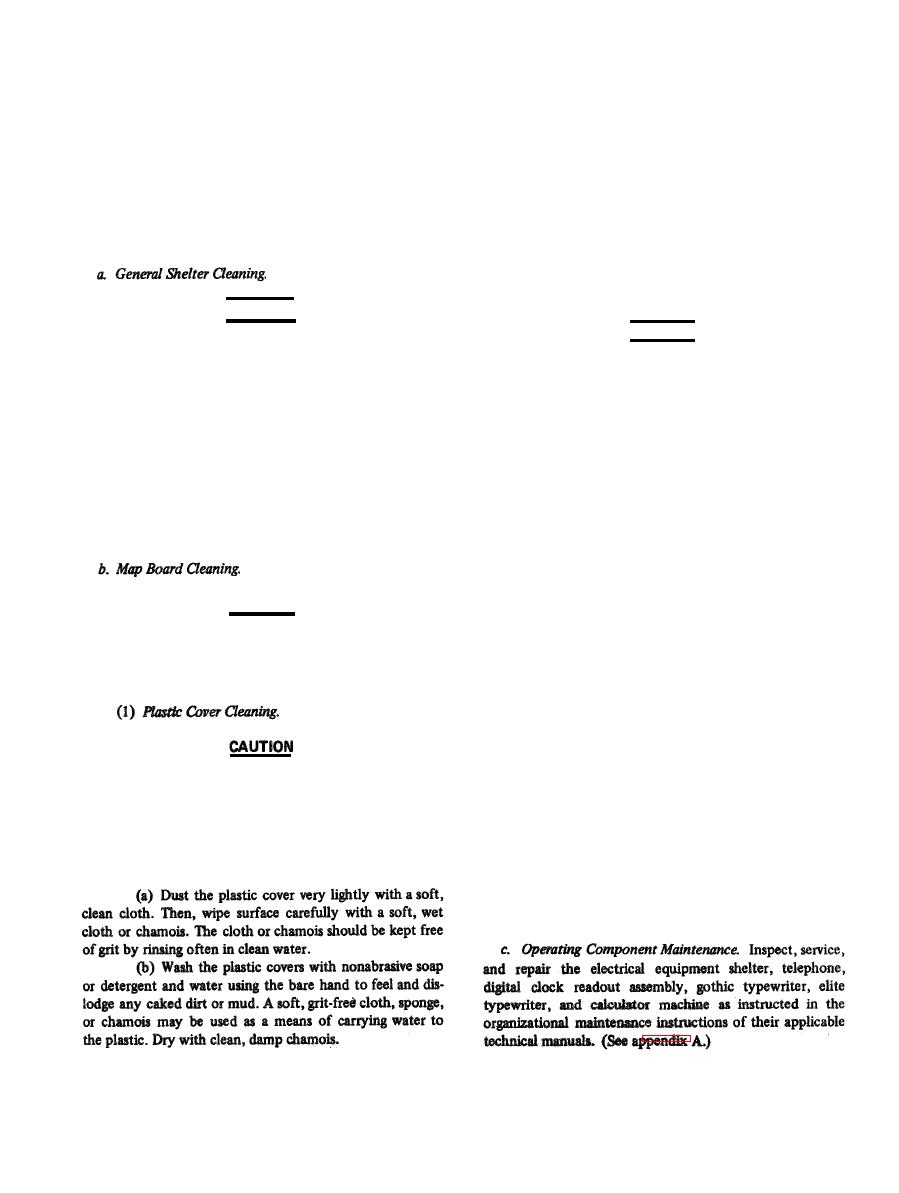
TM 32-5895-248-14&P
Section V. MAINTENANCE OF CENTRAL
(c) Remove grease and oil with prescribed clean-
Organiza-
4-8 ORGANIZATIONAL MAINTENANCE.
ing solvent.
tional maintenance of the central consists of performing the
PMCS plus inspecting, servicing, and repairing the compo-
(2) Plastic Cover Waxing. If, after removing dirt and
nents as indicated below. Servicing includes cleaning,
grease, only a few scratches are visible, the plastic cover
replacing typewriter ribbons, and similar operations.
s h o u l d be waxed with a good grade of commercial wax.
Waxing will improve the appearance of the surface by filling
m i n o r scratches and will help prevent further scratches.
Wax the plastic cover as follows:
WARNING
CAUTION
T h e fumes of cleaning compound, trichloro-
e t h a n e are toxic. Provide adequate ventilation
Excessive rubbing with a dry cloth will cause
whenever it is used. DO NOT USE NEAR AN
s c r a t c h e s and will also build up an electro-
OPEN FLAME. Trichloroethane is not flam-
s t a t i c charge which attracts dust particles to
m a b l e , but exposure to open flame converts
the surface of the plastic cover.
the fumes to a highly toxic and dangerous gas.
(a) Apply wax in a thin, even coat.
Use a dry, clean, lint-free cloth or brush to remove dust and
(b) Bring to a high polish by rubbing lightly with
dirt. If necessary, moisten the cloth or brush with a clean-
a dry, soft cloth, such as cotton flannel, outing flannel,
ing compound to remove grease, oil, dirt, and dust. After
flannelette, or by a machine polisher.
cleaning, wipe dry with a lint-free, dry cloth.
(c) Blot the plastic cover with a clean, damp
chamois or cloth. This will remove the electrostatic charge
a n d any dust particles which have been attracted to the
cover.
CAUTION
( 3 ) Plastic Cover - Hand Polishing. If, after washing,
the surface of the plastic cover shows minor scratches, it
Hard rough cloths should not be used as they
should be hand polished. This will remove or reduce most
will scratch the clear plastic covers and impair
of the scratches. hand-polish the plastic covers as follows:
its optical qualities.
(a) Apply polish with a small pad of soft cotton
flannel dampened with water.
(b) Rub the plastic in a straight to-and-fro motion
p e r p e n d i c u l a r to the scratches or with a circular motion.
Excessive rubbing at one spot should be avoided.
use
solvents such as acetone, benzene,
D o not
( c ) Remove polish with a clean, soft cloth and
carbontetrachloride, lighter fluid, dry cleaning
apply wax after scratches are removed or considerably
f l u i d , or lacquer thinners since they attack plastic
reduced.
surfaces.
D o not use window sprays or scouring
compounds.
(4) R u b b e r B a c k b o a r d - C l e a n i n g . C l e a n r u b b e r
backboard with mild soap and water. Do not close plastic
c o v e r s on rubber while still wet. Keep backboard free of
dust, dirt, grit, and adhesive from masking tape.


